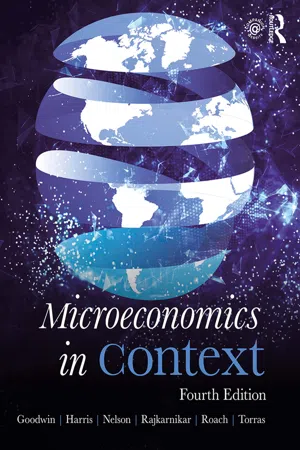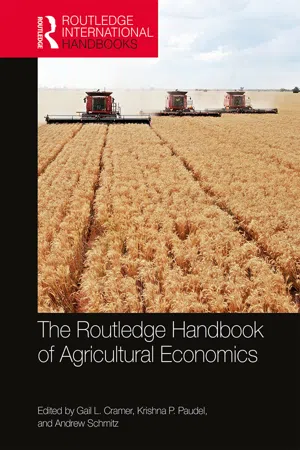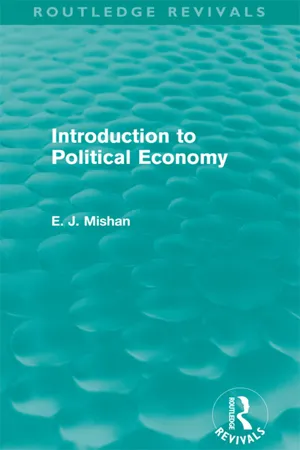Economics
Welfare Effects
Welfare effects refer to the changes in overall well-being that result from a particular economic action or policy. These effects can be measured in terms of consumer surplus, producer surplus, and total surplus. Positive welfare effects indicate an increase in overall well-being, while negative welfare effects signify a decrease.
Written by Perlego with AI-assistance
Related key terms
Related key terms
1 of 4
Related key terms
1 of 3
7 Key excerpts on "Welfare Effects"
- eBook - ePub
- Neva Goodwin, Jonathan M. Harris, Julie A. Nelson, Pratistha Joshi Rajkarnikar, Brian Roach, Mariano Torras(Authors)
- 2018(Publication Date)
- Routledge(Publisher)
Welfare economics is a branch of microeconomics that seeks to estimate the social welfare of different scenarios in order to determine ways to maximize net social benefits. Welfare economics can be studied from both a theoretical perspective and a quantitative applied perspective.welfare economics: the branch of microeconomics that seeks to estimate the social welfare of different scenarios in order to determine how to maximize net social benefitsAs a theoretical approach, welfare economics provides insights into situations in which markets produce desirable outcomes, as well as other situations in which markets either require policy interventions or are ineffective at meeting our final goals. As a quantitative approach, welfare economics seeks to measure social costs and benefits numerically so that different policy scenarios can be compared. Ideally, we can then choose the policy that produces the greatest social welfare.Welfare economics offers an appealing feature—the possibility of measuring the quantitative costs and benefits of different policy scenarios. If this can be done reliably, it should then be possible to simply choose the option that results in the greatest social welfare, where social welfare is defined as total benefits minus total costs, or total net benefits.social welfare: total benefits to society minus total costs, or total net benefitsSome economists use such terms as “social welfare” and “social well-being” interchangeably. However, the two concepts have a subtle, but critical, distinction. As defined above, social welfare is something that can potentially be measured quantitatively, although this approach has numerous limitations. Well-being, which we regard as the final goal of economics, is a broader concept that cannot be measured in quantitative terms. Well-being includes such objectives as fairness, participation, and social relations (recall Table 1.1 in Chapter 1 - eBook - ePub
- Gail Cramer, Krishna Paudel, Andrew Schmitz, Gail L. Cramer, Krishna P. Paudel, Andrew Schmitz(Authors)
- 2018(Publication Date)
- Routledge(Publisher)
Principle 1. Projects and policies of significance affect large groups of individuals.- Principle 2. Evaluation of economic Welfare Effects of projects and policies requires consideration of all affected individuals.
- Principle 3. Heterogeneity in characteristics, conditions, behavior, and perceptions is a widely recognized and critical concern, which implies that analyzing the distribution of Welfare Effects is an important dimension of project and policy analysis in addition to efficiency analysis (Ben-David et al. 1999; Long and Soubeyran 1997; Kirman 2006; Sen 2004).
Some examples illustrate that generalizations are possible by integrating the three bodies of literature on behavioral welfare economics, structural versus reduced form estimation, and sufficient statistics. The producer case is useful as a complementary starting point because these three literatures have focused primarily on consumer issues, whereas many resource and environmental policy issues impact producer behavior.For purposes of comparison of later generalizations, we first outline the standard producer short-run profit maximization model subject only to a technology specification:π ( p , r ) ≡{ p q ( x ) − r x − k | x ≥ 0 } ,maxxwhere output q is non-negative, continuous, concave, and positively monotonic in the input vector x, respective prices are p and r, and k is fixed cost.3 This model has provided the basis for most producer welfare evaluation. First-order conditions yield factor demandsand supplyx ^( p , r ) ≡ −π r.4 Short-run profit is measured by the producer surplus triangle:5q ^( p , r ) ≡π p≡ q (x ^) .S ( p , w ) ≡ pq ^− rx ^=.∫ 0 pq ^( t , r ) d tMarginal WTP followsaccording to slopes of supply and demand, whereas WTP for a discrete change is measured by the change in the producer surplus triangle S for any combination of price and non-price (technology) changes.6d S =q ^d p −x ^d r , - eBook - ePub
The Political Economy of Immigration in The Netherlands
Population, Land and Welfare
- Joop Hartog(Author)
- 2023(Publication Date)
- Routledge(Publisher)
4 Measuring effects on welfareDOI: 10.4324/9781003373773-44.1 Historical developments
The analyses in Chapter 3 focus on income as the criterion variable to assess economic outcomes, whether as wage rates, capital income, aggregate income per capita or GDP growth rate. Yet the core assessment variable in economics is welfare or utility or well-being. At the individual level, more than a century ago economists have turned away from attempting to measure well-being directly, but in recent decades they have taken some bolder steps. At the aggregate, macro-economic level, the goal was never to measure welfare, but measures like National Income or Gross National Product (GNP) have gradually been pushed into a role of measuring national economic success. This habit has also come under increased scrutiny, and many alternatives and refinements have been developed. In this chapter, we will discuss these developments in micro- and macro-economics in some detail, for proper understanding of meaning and scope of the alternative measures. We will then present empirical results collected from these approaches on effects of population density. Such effects are not systematically studied within each of the alternative approaches, and we necessarily end up with a kaleidoscopic set of results. More is needed but what we have is certainly not negligible.To economists in the 19th century, utility had few secrets. Blaug (1980 , p. 164) refers to the introspective cardinalism of Jevons, Menger, Walras en Marshall: simply knowing the sources of utility from personal experience and social observation. As Paul Samuelson noted: To Edgeworth, utility is as real as his morning jam - eBook - ePub
- Randall Holcombe(Author)
- 2013(Publication Date)
- Routledge(Publisher)
8 Economic welfare Theory and policyThe subject matter of economics has always revolved around how to design policies to improve economic well-being. Indeed, Adam Smith’s complete title, An Inquiry Into the Nature and Causes of the Wealth of Nations , reveals his intention to explain how people are able to create wealth by working together well beyond what any individual could achieve alone. He begins by saying, "The greatest improvement in the productive powers of labour ... seem to have been the effects of the division of labour,"1 and goes on to give the delightful example of the pin factory in which he argues that people are hundreds of times more productive when they specialize their labor, and increase their well-being by trading with others who specialize in different productive activities. Just by looking at the prosperity that characterizes the modern world – in those parts of the world that have a well-functioning market economy – there can be no doubt that economic welfare is advanced by the results of resource allocation within a market setting.While economic welfare has always been the central subject matter of economics, modern welfare economics can trace its origins to A.C. Pigou’s The Economics of Welfare , originally published in 1920. Pigou notes that there is a difference between economic and non-economic welfare, and limits his study to the former. Neoclassical welfare economics followed Pigou’s lead in this regard, and this chapter will do the same. Pigou goes on to note, "What we wish to learn is, not how large welfare is, or has been, but how its magnitude would be affected by the introduction of causeswhich it is in the power of statesmen or private persons to call into being."2 - eBook - ePub
- Michael Oxley(Author)
- 2004(Publication Date)
- Bloomsbury Academic(Publisher)
et al., 2003, pp. 211–28). Whether, on balance, such actions are desirable can only be answered by referring to the interest of society rather than the interests of individuals. Welfare economics acknowledges a social well-being which is different from the sum of the well-being of those who compose the society.Planning is based on the proposition that land use can usefully be determined within a policy framework. A policy may be seen as a deliberate course of action designed to improve the welfare of society. For such action there must be objectives. Welfare economists have traditionally sought to make important divisions between what welfare economics can and cannot say about policy objectives. It has been argued that ‘It is not possible for economic analysis to determine what the objectives of society ought to be, nor whether a particular social state is better than another. Such questions are the subject matter of moral and political philosophy’ (Winch, 1971, pp. 13–14). Welfare economics attempts, according to this perspective, only to advise on the appropriateness of actions to achieve these objectives, not the appropriateness of the objectives themselves. The implied separation between policy objectives and policy instruments can, however, be highly misleading. Suppose that the welfare economist is told that an objective of society is to limit the increases in rents that tenants pay. The recommended course of action might be to control or fix rents. Rent control, as a policy instrument, might however be predicted to lead to unwanted consequences such as shortages of accommodation. By questioning the given objective and asking why rents should be limited, the welfare economist may discover that rent limitations are preconceived to be the means to some other end such as ‘preventing exploitation’ or ‘making housing more affordable’. The economist has a role in questioning the objectives as well as prescribing possible instruments, and the questioning should lead to a clarification of the objectives as well as a better specification of the instruments. The clarification of objectives and a statement on what the aims - eBook - ePub
Global Trade Policy
Questions and Answers
- Pamela J. Smith(Author)
- 2013(Publication Date)
- Wiley-Blackwell(Publisher)
Intuitively, the effects of export subsidies on prices and quantities provide information about their impact on both producers and consumers. At home, producers are supplying more at a higher price. They have gained from the subsidy in terms of revenue from sales of the good. At home, consumers are demanding less at a higher price. They have lost from the subsidy in terms of the cost of the good. Alternatively, in the foreign country, producers are supplying less at a lower price. They have lost. And foreign consumers are demanding more at a lower price. They have gained. Further, the mix of production for the domestic and international markets changes as a result of the export subsidy. Producers in the home country now produce more for the export market and less for the domestic market. Producers in the foreign market continue to produce goods only for their domestic market, but fewer of them.The Welfare Effects of the export subsidy for the home and foreign countries can also be seen in Figure 6.1 and are summarized in Table 6.1 . Instead of illustrating total welfare before and after the subsidy is imposed, we simply illustrate the changes in welfare that result from the subsidy. Panel (a) in Figure 6.1 shows the Welfare Effects for the home country (exporter). As shown, the producer's welfare increases by the surplus amount +(a + b + c) as a result of the subsidy. The consumer's welfare decreases by the surplus amount −(a + b) as a result of the subsidy. Furthermore, the government welfare decreases by the amount −(b + c + d + e + f + g + h + i) as a result of the subsidy. This change in government welfare is the cost of paying the subsidy. It is the product of the quantity exported (horizontally) and the value of the subsidy (vertically).Table 6.1Welfare Effects of exports subsidies.Case 1 – Large country Economic agent Welfare Effects (exporter/home) Welfare Effects (importer/foreign) Producer +(a + b + c) −(a* + e*) Consumer −(a + b) +(a* + b* + c* + d* + e*) Government +(b + c + d + e + f + g + h + i) 0 Country −(b + d + e + f + g + h + i) +(b* + c* + d*) Country (direction) Negative Positive Case 2 – Small country Economic agent Welfare Effects (exporter/home) Welfare Effects (importer/foreign) - E. Mishan(Author)
- 2013(Publication Date)
- Routledge(Publisher)
The claim that there can be any number of different definitions, and therefore indices, of social welfare, is undeniable but not pertinent to the main issue. The impression conveyed by such an allegation is that welfare economics is actually a sophisticated game which an economist may play with any welfare definition that happens to catch his fancy. Far from being arbitrary or capricious, however, the definition of social welfare can be acceptable as a foundation for the subject only if it is an appropriate one for the particular society to which the economist is to address his welfare prescriptions. To be more precise, if the economist's welfare prescriptions are to be taken seriously by society, the ethical premises on which his criteria rest must accord with those held by society at large; this view will be elaborated in Chapter 3. A second source of dissatisfaction with welfare economics is that none of its propositions can be shown to be generally valid. Indeed, as is often alleged, welfare economists resort to criteria that appear to be self-contradictory (Graaff 1957; Nath 1964). This latter apparent paradox will be discussed in Part Four, where I will also argue that there is a necessary connection between changes in prices and changes in distribution. The more general dissatisfaction stemming from the lack of generality of the propositions of Welfare economics (and we shall confirm as much later) is no more warranted than a dissatisfaction with the lack of generality in positive economics. The trouble with what are called ‘general propositions’ is that they are commonly but unreasonably conceived of as meaningful propositions which should hold true in all circumstances – that is to say, whatever the assumptions about the nature of technology, institutions or people's behaviour. But this notion of generality is impossible. In an economic universe that can take any shape imaginable any result becomes possible
Index pages curate the most relevant extracts from our library of academic textbooks. They’ve been created using an in-house natural language model (NLM), each adding context and meaning to key research topics.
Explore more topic indexes
Explore more topic indexes
1 of 6
Explore more topic indexes
1 of 4






